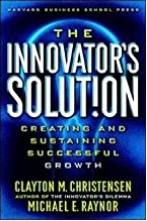Clayton M. Christensen and Michael E. Raynor offer a follow-up to Christensen’s best-selling The Innovator’s Dilemma, presenting a clear blueprint to disruptive innovation.

Seek the Bottom
The late Clayton M. Christensen – former Harvard Business School professor and author of The Innovator’s Dilemma, among other landmark titles – partnered with Deloitte Research’s Michael E. Raynor – author of The Strategy Paradox – to parse the dilemmas facing top-ranking companies.
The authors explain that disruptive innovations typically debut at the low end of the market as unprofitable, unpromising and crude products. At that moment, Christensen and Raynor warn, established companies ignore them – but later those innovations overtake them. Christensen’s classic, The Innovator’s Dilemma, identified this problem. Here, he and Raynor help managers identify potentially disruptive innovations, and read and respond to the market and the competitive environment.
If indeed there are predictable reasons why businesses stumble, we might then help managers avoid those causes of failure and help them make decisions that predictably lead to successful growth.Clayton M. Christensen and Michael E. Raynor
The Financial Times said of this Wall Street Journal and New York Times bestseller, “Fresh thinking aplenty…nothing less than a handbook for managers who would rather disrupt than be disrupted.” The Toronto Globe & Mail found it, “A promising blueprint for innovation.” And The New York Times called it, “an instructive tutorial on how to rekindle the spark of youth and nurture the fragile flame.”
Greatness
The innovator’s dilemma, Christensen and Raynor explain, is that to become great, a company must listen to its customers; direct its investments to the highest return opportunities; improve its products; manage its relationships with suppliers; and correctly assess and cope with competitive threats.
The authors identify two kinds of innovations: sustaining innovations that improve existing products and offer better performance against established, mainstream metrics; and disruptive innovations that offer less performance, but prove adequate, smaller, easier to use and cheaper – and are desirable to large market segments.
Industry leaders get blindsided by disruptive innovations precisely because they focus too closely on their most profitable customers and businesses. Clayton M. Christensen and Michael E. Raynor
Christensen and Raynor note the irony that an established company ignoring a disruptive innovation is making a perfectly rational choice at that moment. However, they describe how a vacuum opens at the low end of the market, where less demanding, more price-conscious customers feel forced to buy more functionality and performance than they need; disruptive innovators fill this vacuum.
Solutions
Christensen and Raynor urge you to seek markets in which you have no competition or markets that your established competitors avoid. They make an interesting argument when they avow that you should never compete with non-consumption. Satisfied customers, they say, are not a growth market. Therefore, you should find customers who are seeking something because they have nothing; for example, at the time few Chinese consumers had air conditioning, so an affordable, functional cheaper machine could compete effectively with non-consumption.
Customers don’t just ‘change jobs’ because a new product becomes available.Clayton M. Christensen and Michael E. Raynor
Continuing their push to the low end, Christensen and Raynor remind you that products that offer sound profit margins today might not offer the same margins tomorrow. Likewise, they urge you to consider where profit opportunities will be in the future and to develop competencies to take advantage of them.
Christensen and Raynor argue against trying to make customers change their established priorities or habits; offer them a way to keep doing what they are doing, but more easily and for less money. The authors make a compelling case for defining market segments on usage patterns, not well-known norms. Segment the market, they recommend, according to what customers seek to accomplish.
The authors push you to distrust the trustworthy. Thus, Christensen and Raynor foretell, managers who did the best job for you in the past may not be able to spearhead a new venture. When looking for people to lead a disruptive innovation, they propose, find employees who solved problems similar to those they will encounter – don’t think in terms of attributes or previous responsibilities.
Christensen and Raynor caution you about committing to a strategy and advise demanding evidence it works before you implement it. When people make up their minds too quickly about a strategy, the authors advise, that is a danger signal.
Impatient for Profits, Patient for Growth
Christensen and Raynor encourage you to be impatient for profits; reject proposals promising years of losses, because that approach is about sustaining, not disrupting. Let your well-established competitors worry about sustaining innovation.
Competitiveness is far more about doing what customers value than doing what you think you’re good at.Clayton M. Christensen and Michael E. Raynor
At the same time, Christensen and Raynor exhort you to be patient for growth; you cannot force a disruptive innovation to go faster than the market allows. They warn that managers who make a new business grow too fast may attempt to force your disruptive technology to suit an old, existing market. That is a path to failure.
Follow Up
This sequel proves not quite as innovative or provocative as its predecessor, but it offers a valuable extension of Christensen’s theories and greater detail in overcoming the problems he cited in his earlier work. The authors are not the liveliest prose stylists, and occasionally make their key points more than once, but their functional blueprint is clear, actionable and vested in practical common sense. If you want to know what your company can do about serious competitive problems, this solid follow-up remains worthy and valuable. You might increase its value if you also read The Innovator’s Dilemma.
Clayton M. Christensen also authored or co-authored How Will You Measure Your Life?, Competing Against Luck, The Innovator’s DNA and The Prosperity Paradox. Michael E. Raynor authored or co-authored The Innovator’s Manifesto and The Three Rules.







